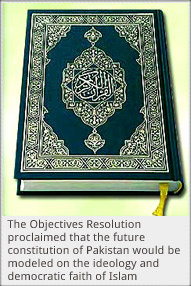The history of formulation of the constitution of Pakistan begins with the Lahore Resolution in 1940. It was here that the idea of Pakistan, a separate homeland for the Muslims of India, was first outlined. It came to be known as the Pakistan Resolution.
On June 3, 1947, the British Government accepted in principle the partition of India in order to create two independent dominions of Pakistan and India. The British Parliament passed the Indian Independence Act on July 18, 1947. Accordingly, the new state of Pakistan came into being on August 14, 1947. This new state was formed of East Bengal, a part of Assam (Sylhet), West Punjab, Sindh, N. W. F. P. and Baluchistan provinces of undivided India.
Under Section 8 of the Indian Independence Act of 1947, the Government of India Act of 1935 became, with certain adaptations, the working constitution of Pakistan.
However, the Quaid’s aim was the establishment of a truly Islamic society. As a result, a Constituent Assembly was set up under the Independence Act. The Constituent Assembly had a dual purpose; to draft the constitution of Pakistan and to act as a legislative body till the new constitution was passed and enforced.
Objectives Resolution
On March 12, 1949, the Constituent Assembly adopted a resolution moved by Liaquat Ali Khan, the then Prime Minister of Pakistan.
 It was called the Objectives Resolution. It proclaimed that the future constitution of Pakistan would not be modeled on European pattern, but on the ideology and democratic faith of Islam.
It was called the Objectives Resolution. It proclaimed that the future constitution of Pakistan would not be modeled on European pattern, but on the ideology and democratic faith of Islam.
The Objectives Resolution, which is considered to be the “Magna Carta” of Pakistan’s constitutional history, proclaimed the following principles:
- Sovereignty belongs to Allah alone but He has delegated it to the State of Pakistan through its people for being exercised within the limits prescribed by Him as a sacred trust.
- The State shall exercise its powers and authority through the chosen representatives of the people.
- The principles of democracy, freedom, equality, tolerance and social justice, as enunciated by Islam, shall be fully observed.
- Muslims shall be enabled to order their lives in the individual and collective spheres in accordance with the teachings of Islam as set out in the Holy Quran and Sunnah.
- Adequate provision shall be made for the minorities to freely profess and practice their religions and develop their cultures.
- Pakistan shall be a federation.
- Fundamental rights shall be guaranteed.
- Judiciary shall be independent.
The Objectives Resolution is one of the most important and illuminating documents in the constitutional history of Pakistan. At the time it was passed, Mr. Liaquat Ali Khan called it “the most important occasion in the life of this country, next in importance only to the achievement of independence”.
The importance of this document lies in the fact that it combines the good features of Western and Islamic democracy. It is a happy blend of modernism and Islam. The Objectives Resolution became a part of the constitution of Pakistan in 1985 under the Eighth Amendment.
This article was last updated on Sunday, June 01, 2003






